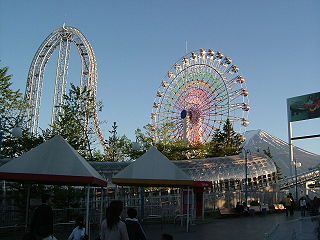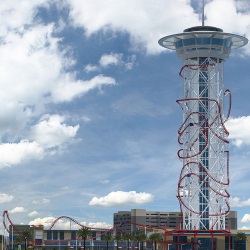
A roller coaster is a type of amusement ride employing a form of elevated railroad track that carries passengers on a train through tight turns, steep slopes, and other elements designed to produce a thrilling experience. Trains consist of open cars connected in a single line, and the rides are often found in theme parks around the world. Roller coasters first appeared in the 17th century, and LaMarcus Adna Thompson obtained one of the first known patents for a roller coaster design in 1885, based on the Switchback Railway which opened a year earlier at Coney Island.

A steel roller coaster is a roller coaster that is defined by having a track made of steel. Steel coasters have earned immense popularity in the past 50 years throughout the world. Incorporating tubular steel track and polyurethane-coated wheels, the steel roller coasters can provide a taller, smoother, and faster ride with more inversions than a traditional wooden roller coaster.

The generic roller coaster vertical loop, also known as a Loop-the-loop, or a Loop-de-loop, where a section of track causes the riders to complete a 360 degree turn, is the most basic of roller coaster inversions. At the top of the loop, riders are completely inverted.

A roller coaster inversion is a roller coaster element in which the track turns riders upside-down and then returns them to an upright position. Early forms of inversions were circular in nature and date back to 1848 on the Centrifugal railway in Paris. These vertical loops produced massive g-force that was often dangerous to riders. As a result, the element eventually became non-existent with the last rides to feature the looping inversions being dismantled during the Great Depression. In 1975, designers from Arrow Development created the corkscrew, reviving interest in the inversion during the modern age of steel roller coasters. Elements have since evolved from simple corkscrews and vertical loops to more complex inversions such as Immelmann loops and cobra rolls. The Smiler at Alton Towers holds the world record for the number of inversions on a roller coaster with 14.

Intamin Amusement Rides is a design and manufacturing company in Schaan, Liechtenstein, best-known for designing and constructing thrill rides and roller coasters at dozens of international theme parks, amusement parks and other establishments. The Intamin brand name is a syllabic abbreviation for " international amusement installations". The company has corporate offices across the world, including three in Europe, three in Asia, and two in the United States.

A roller coaster train is a vehicle made up of two or more cars connected by specialized joints which transports passengers around a roller coaster's circuit. Roller coasters usually have various safety features, including specialized wheels and restraints.

Nemesis Reborn, previously Nemesis, is an inverted roller coaster located at the Alton Towers theme park in Staffordshire, England. Manufactured by Bolliger & Mabillard (B&M), the ride was designed by Werner Stengel, while overall development was overseen by attraction developer John Wardley. It opened in the Forbidden Valley area of the park on 19 March 1994.

Do-Dodonpa (ド・ドドンパ), formerly known as Dodonpa (ドドンパ), was a steel roller coaster located at Fuji-Q Highland in Fujiyoshida, Yamanashi, Japan. Manufactured by S&S – Sansei Technologies, the launched coaster used compressed air to propel its trains. It opened on 21 December 2001 as the fastest roller coaster in the world with the fastest acceleration, reaching a top speed of 172 km/h (106.9 mph) in 1.8 seconds. The ride was refurbished in 2017, removing its top hat element in favor of a vertical loop, as well as increasing its speed and acceleration to 180 km/h (111.8 mph) in 1.56 seconds. In 2021, the ride was closed down indefinitely after multiple complaints of riders sustaining broken bones were raised. The ride's permanent closure was officially announced on 13 March 2024.

Galactica is a flying roller coaster located in the Forbidden Valley area of Alton Towers amusement park in Staffordshire, England. It originally opened as Air on 16 March 2002 and is the first flying coaster manufactured by Bolliger & Mabillard. Guests ride in a prone position, meant to produce the feeling of flight, as the train passes close to the ground, under footpaths, and narrowly past trees and rocks. The ride was refurbished for the 2016 season and reopened as Galactica. It features an 840-metre-long (920 yd) track and reaches a maximum speed of 75 km/h.

Nemesis Inferno is a steel inverted roller coaster at the Thorpe Park theme park in Surrey, England, UK. Its layout was conceived and designed by John Wardley and then built by Bolliger & Mabillard with Werner Stengel providing the layout calculations, the same Swiss firm that built the related Nemesis inverted roller coaster at Alton Towers. As a result, Nemesis and Nemesis Inferno are often compared. It is also listed on the Alton Towers website that the ride is “Nemesis’ Sister”.

Volcano: The Blast Coaster, or simply Volcano, was an inverted roller coaster located at Kings Dominion in Doswell, Virginia, United States. Designed by Werner Stengel, it was the first launched roller coaster manufactured by Intamin and the first of its kind in the world to be inverted. Its launch mechanism utilized linear induction motor (LIM) technology. After a series of delays, Volcano opened to the public on August 3, 1998. A portion of the ride was enclosed inside an artificial mountain, constructed in 1979, which previously housed other attractions. Following nearly two decades of operation, Volcano abruptly closed a few weeks into the 2018 season, and the closure became permanent during the following offseason.
NoLimits Roller Coaster Simulation is a software package available for Microsoft Windows and Mac OS X designed and built by a team of programmers and artists led by German programmer Ole Lange. It was first released in November 2001. The package includes two separate pieces of software, the NoLimits Editor and NoLimits Simulator, with a third application of the game, the NoLimits Terraformer supported as well.

Fantasy Island is a Resort Theme Park located in Ingoldmells on the East Coast of Lincolnshire.

The Odyssey is a roller coaster at Fantasy Island in Ingoldmells, England. Built by Vekoma of the Netherlands in 2002, it was named to commemorate the Golden Jubilee of Queen Elizabeth II. It is Vekoma's tallest example of their Suspended Looping Coaster (SLC) design in the world. Standing at 167 feet, it is the fourth tallest roller coaster in the UK, after Hyperia the Big One and Stealth. And the joint second tallest full circuit inverted rollercoaster in the world. It has a maximum speed of 63 mph and is capable of forces up to 4.8g.
The physics of roller coasters comprises the mechanics that affect the design and operation of roller coasters, a machine that uses gravity and inertia to send a train of cars along a winding track. Gravity, inertia, g-forces, and centripetal acceleration give riders constantly changing forces which create certain sensations as the coaster travels around the track.

The Smiler is a steel roller coaster located at Alton Towers in Staffordshire, United Kingdom. It opened in 2013 as the first Infinity Coaster model from Gerstlauer and was built in the X-Sector area of the park. The Smiler features 14 inversions, which is a world record for most inversions on a roller coaster.

Skyscraper was a roller coaster concept originally planned for a future Skyplex entertainment complex located in Orlando, Florida. Development began in 2012 by American manufacturer US Thrill Rides and Swiss manufacturer Intamin, with both companies designing the attraction as the first Polercoaster model utilizing an observation tower for its main support structure. Skyscraper would have been the tallest roller coaster in the world at over 500 feet (150 m), and it would have featured both the steepest drop and highest inversion in the world.

Steel Taipan is a steel launched roller coaster at Dreamworld in Coomera, Queensland, Australia. Steel Taipan is a direct replacement to the former Thunder River Rapids Ride. The roller coaster, the first triple-launched coaster in the Southern Hemisphere, is named after the deadly Taipan family of snakes native to Australia.

Sik is a steel roller coaster at Flamingo Land in North Yorkshire, United Kingdom. It opened to the public on 2 July 2022.


















